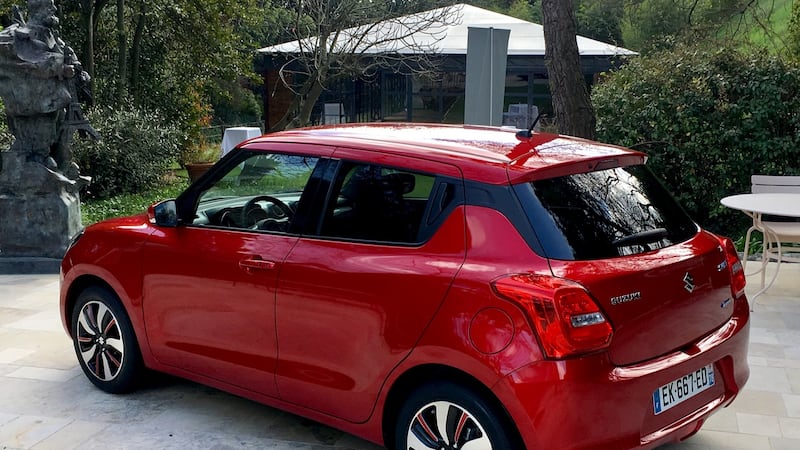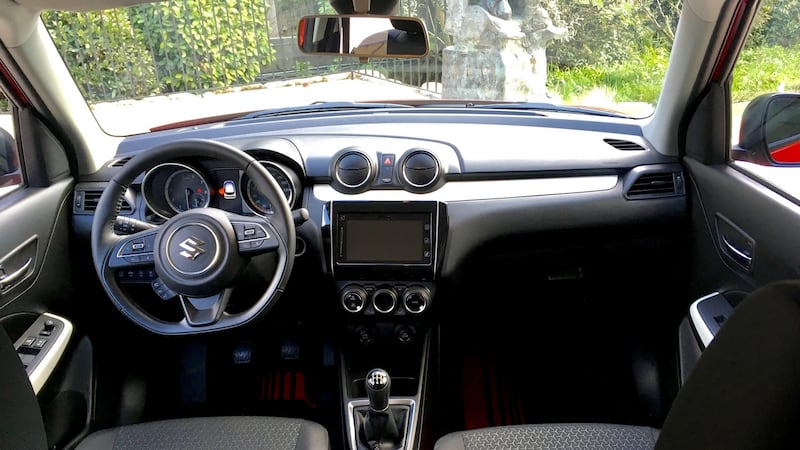Since its launch in 2005 Suzuki has sold 5.4 million Swifts worldwide with over a million of those sales in Europe. Numbers in Ireland are more humble and it is not surprising as Suzuki remains something of an unknown brand, struggling to get its voice heard against the mainstream brands. Hence it has a tiny market share and dealer network. And so the spiral continues for smaller car brands.
Suzuki may be an underdog but it has a deserved reputation as a maker of good small cars and SUVs. The latest Swift is an all new model that slots in between the Ignis and larger Baleno and we are told will be priced accordingly. That could mean prices in the region of €15,000 or more.
The three-door Swift that was also the entry point is discontinued as it was a poor seller globally. This leaves the popular five-door hatch the only body shape on sale.


Swift is built on a new platform that offers improved interior space yet remains refreshingly compact on the outside. Up front the extra space is particularly noticeable thanks to the front seats been repositioned further apart. As you’d expect there is more standard equipment and greater connectivity, plus if you pay the top-end price you get a host of driver safety aids.
The old Swift was a well regarded car but the main criticism from owners concerned it’s tiny boot. That issue has been addressed with a visibly longer floor that sees boot capacity increase by 20 per cent to a usable 265 litres. A space saver spare wheel is a circa €250 option.
Swift’s exterior continues to be curvy and disarming but it does require closer attention to see interesting detail. The old car was an instantly likeable machine with smooth curves and soft lines whereas the new Swift is more divisive in the looks department.
There is a slight nod to the sharper styling trend we are seeing more of form Japan via the new headlights, grille and bumper treatments. Suzuki has clearly resisted the more angular styling approach of the likes of new Micra. The new Swift is also a different version in Europe than what is on sale in Japan. It is 40mm wider, for example, while the suspension and steering have been tuned for Europe, which generally means stiffened and sharpened up. The extra width over Japan's domestic Swift gives the European Swift a more purposeful and almost squat stance on the road.
Inside, the dash has been reworked and is well packaged, the only criticism is the lack of soft touch dash surfaces that are appearing more often in small cars with more premium leanings. Rear space is perfect for two adults or three kids. There is ample head and shoulder room and I was able to comfortably sit behind my own 5’10” driver’s seat position. The front seats are large and supportive but you feel even more rear space could have been freed up by using thinner seat backs.
The new Swift has lost weight and is now 100kg lighter weighing in at just 890kg in base trim – that’s roughly the same weight as the Ireland rugby pack. This transformation has a big effect on improving fuel consumption and performance.
Under the bonnet petrol power comes from the excellent 3 cylinder 1 litre Boosterjet with 111hp and 170nm of torque or a 1.2 litre Dualjet four cylinder with 90hp and 120nm of torque.
Mild hybrid versions are available with both engines, under the less than catchy title of “Small Hybrid Vehicle by Suzuki” (SHVS). The same system is available with Baleno and Ignis, but not with the 1.2 litre engine. A small rechargeable lithium Ion battery pack sits underneath the passenger’s seat and a clever integrated starter generator in the engine bay takes the workload away from the car’s 12 volt battery and starter motor. The conventional starter motor is only used to start the car from cold. The mild hybrid system adds only 6.5kg in total to the car’s weight but it adds power under hard acceleration, helps deliver lower CO2 emissions (as low as 97g/CO2) while also lowering fuel consumption.
At the European launch centre we tested the 1-litre SHVS version with the standard five speed manual gearbox. The three cylinder turbo powertrain is a terrific little engine. The turbo is bolted to the engine to let it spin up sooner and there is really impressive low-end pulling power. The Swift lives up to its name and 111hp feels more like 130hp in the lightweight front wheel drive hatch.
On the motorway it cruises quietly and will fill the mirrors of larger cars effortlessly if provoked. On twisty mountain roads the car proved predictable and was even fun to flick through bends. Credit must go to the suspension tuning team that used UK and German roads to tune the shock absorbers for European tastes.
The five door hatchback will be sold in three grades: SV3, SVT and SV5. The standard level of equipment is good with six airbags, leather steering wheel, DAB radio, daytime running lights, Bluetooth, air conditioning and rear privacy glass.
The mid-range SVT will be the volume selling grade and along with SV5 will feature Apple CarPlay and Android Auto phone connectivity displayed through a centre tablet-like touch screen. The entry SV3 loses the tablet display and gets an integrated CD stereo instead that surprisingly doesn’t look too out of place.
Sadly at the price-sensitive end of the car market safety equipment is often sacrificed to keep the retail price competitive. The safest Swift is the most expensive SV5 version.
It has a host of the current crop of driver aids that will help mitigate or in some cases completely avoid collisions. Under the Suzuki banner of Total Effective Control Technology (TECH) buyers of the standard car get ESP and a strong bodyshell that should perform well in crash tests but it’s only the SV5 that gets the good stuff.
Advanced Forward Detection System combines a windscreen mounted single lense camera and a laser sensor to detect potential collisions and can intervene using autonomous braking if necessary. Lane departure warning features also utilising millimetre-wave radar.
The Weaving Alert function caught our attention as it identifies changes in driver behaviour to spot potential tiredness and alerts the driver both visually and audibly if they are straying within their lane. Adaptive cruise control, headlight high beam assist and dual sensor brake support – that primes the brakes in an imminent collision situation, again are star features only in the top level Swift.
In Ireland Swift accounts for about 10 per cent of Suzuki’s car sales with Vitara it’s clear volume seller at more than 50 per cent. Suzuki Swift goes on sale in Ireland at the start of June.
Suzuki Swift 1.0 Boosterjet SHVS
Price: TBA
Engine: 998cc 3 cylinder petrol turbo with mild hybrid
Power: 111hp
Torque: 170nm engine only
0-100kph: 10.6 seconds
Top speed: 195km/h
Claimed fuel economy: 4.3 l/100km (65.7mpg)
Emissions: 97g/CO2
Motor Tax: €180
Verdict: Swift is bigger inside yet refreshingly compact outside plus it is very easy to use.
Rating: 4 stars
















